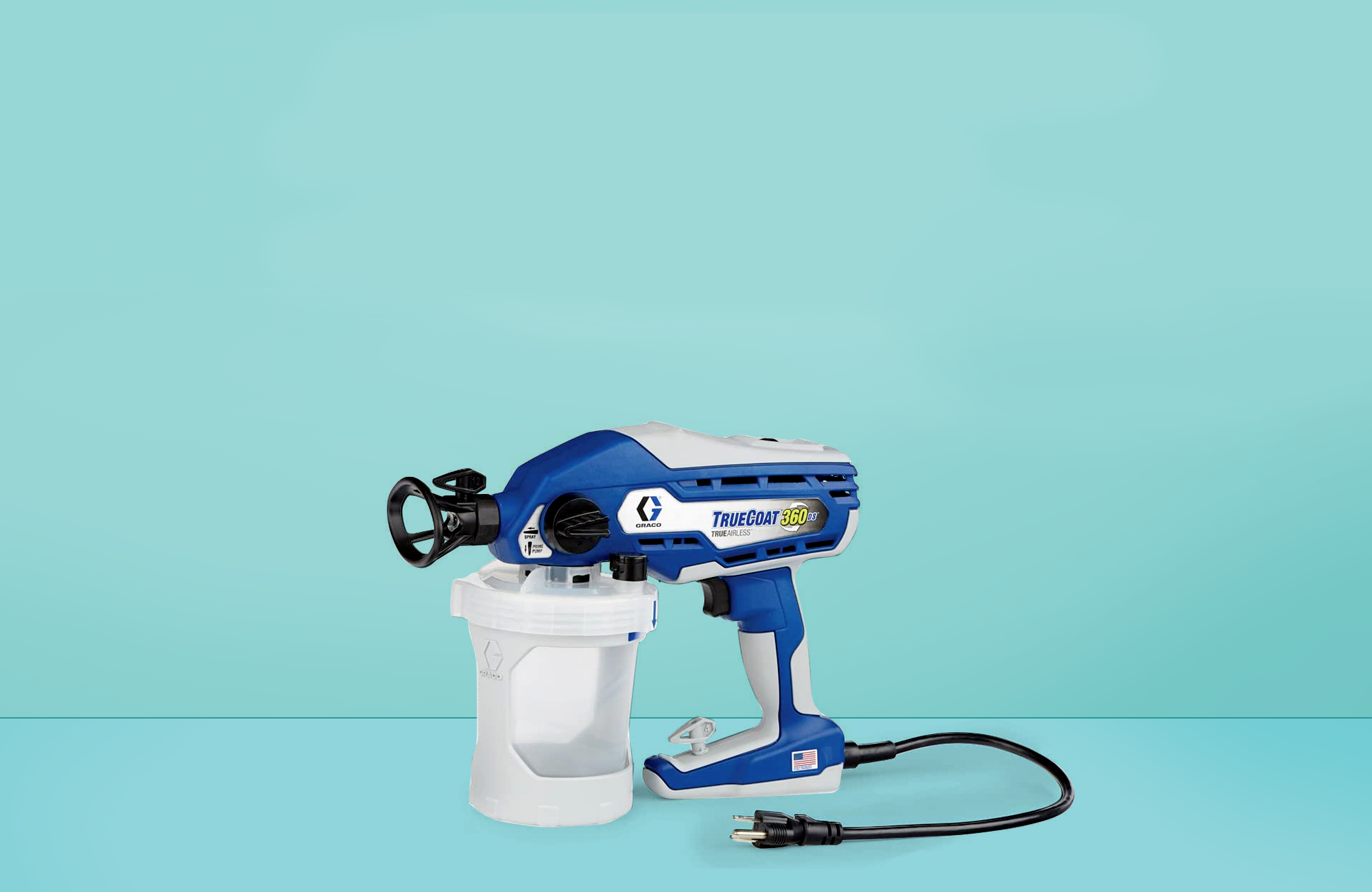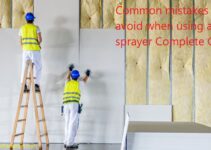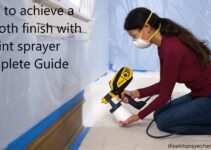Are you looking for the perfect paint sprayer to give your DIY project a professional finish? Finding the perfect sprayer can be overwhelming but don’t worry, we’ve got you covered.
With this complete guide, selecting the right paint sprayer for your project is now easier than ever, giving you flawless results with minimal effort. Let’s get started!
Choosing the best painting tool for your project can be a challenging process. For a beginner, the number of options and possibilities can seem overwhelming, confusing and difficult to navigate.
This guide will help you choose the right paint sprayer for your project, taking into account your specific needs and budget. After reading this guide, you will have a better understanding of paint sprayer types, factors to consider when selecting a paint sprayer, as well as information on maintenance and storage.
Armed with this knowledge, you will be ready to choose the right paint sprayer for your project!
Importance of choosing the right paint sprayer
The right paint sprayer is essential for achieving a professional-grade finish on your project. The wrong paint sprayer can lead to poor results, including uneven coverage, drips, and an unappealing texture. To help you choose the best model for your job, it’s important to understand how different factors such as nozzle size, pressure range and flow rate affect the quality of your paint job.
A few key considerations to bear in mind when selecting a paint sprayer include:
- Nozzle size: Determines the amount of material that can be sprayed at one time
- Pressure range: The higher the pressure range, the thicker materials (such as latex) can be used
- Flow rate: determines how quickly work is completed – faster than a roller or brush
- Portability: A lightweight sprayer is ideal for taking on larger projects without having to move it too often
- Versatility: The right model should be able to tackle different kinds of surfaces such as brick, wood and metal
Comparing these features will ensure that you’re using the right machine for your specific painting needs.

Benefits of using a paint sprayer
Using a paint sprayer can provide a range of benefits, from creating an even, smooth finish to increasing the speed and efficiency of the project. Paint sprayers can be used for various types of jobs and materials – from small-scale craft projects to large-scale industrial painting jobs. The main advantages of using a paint sprayer include:
-Increased coverage: Paint sprayers can provide an even and consistent coating across the surface being painted. This is especially beneficial for larger areas, as it reduces the amount of time and effort required to achieve a comprehensive coverage.
-Time savings: Paint sprayers can often help to speed up the painting process. By providing an even and efficient coat, they can help reduce the overall time needed to complete the project.
-Cost assessment: Using a paint sprayer allows users to accurately estimate how much paint will be required for their job. This makes it easier to budget for supplies in advance as well as helping identify any potential overspend on items such as paints or primer.
-Versatility: Paint sprayers are suitable for use on various materials including wood, metal, fiberglass and plastic surfaces – making them ideal for most DIY projects such as furniture refinishing or outdoor deck painting. With some models featuring various nozzle settings, they allow users to adjust the coating thickness according to their needs – ensuring only the necessary amount of liquid is used per job without over spraying or wasting material however large or small the scale task may be.
Overview of the guide
This guide will help you decide which type of paint sprayer is right for your project. Whether you are dealing with an interior or exterior project, we have all the information you need to make the best choice.
We will look at the types of sprayers available from compressed air to electrostatic and how their performance can vary. We’ll also provide tips and suggestions so that you can get the most out of your paint sprayer no matter which one you end up choosing.
Finally, we’ll provide a few suggestions on how to test out different kinds of paint sprays in order to pick the best one for your needs. With all this information in mind, let’s dive into how to choose the right paint sprayer for your project!
Factors to Consider When Choosing a Paint Sprayer
When buying a paint sprayer, there are many factors to consider. It’s important to have a clear understanding of your requirements, the types of paints and materials you’ll be using, and the environment you’ll be using the sprayer in before making a purchase decision. Some of the most important factors include:
1.Features: Paint sprayers come with different features that can make them more or less suitable for different projects. Factors such as adjustable triggers, adjustable pressure settings, and turbine motor power are key things to look out for when shopping for a paint sprayer.
2.Quality: Paint quality is just as important as the quality of your paint sprayer. It’s essential to invest in one that is suited to your job and offers high-quality performance. The type of material being painted will also determine the best paint for use with certain sprayers; always check label information before purchase for best results.
3.Noise Level: Make sure you know how much noise the model emits before deciding on which one to choose. The loudness levels can vary quite drastically between models and you should take this into consideration when deciding what kind of paint sprayer would work best in your space or area of use.
4.Ease of Use: Look into any additional features that may make using the particular model easier or more efficient such as an adjustable handle, airless options, quick-release cords etc which could maximize convenience during larger projects or jobs taking place over longer periods of time.
Project size
For larger areas (220 to 308 square feet) or jobs that require a considerable investment of time and effort, you may want to consider investing in a professional grade paint sprayer. A professional grade paint sprayer is designed for heavy duty use on large projects and will produce a higher quality finish with less overspray. Professional grade sprayers are generally powered by compressed air, electric motors or hydraulic pumps, which makes them more powerful than standard paint sprayers.
For smaller projects (under 220 square feet), a high-pressure, low-volume (HVLP) style sprayer is probably more than adequate. HVLP paint sprayers use less pressure than conventional ones so they create less overspray, making them suitable for smaller projects or when precision is important.
When selecting an HVLP paint sprayer, it is important to look at the nozzle tip size and its flow rate since these affect the amount of material that’s dispensed.
Type of paint
When it comes to choosing the right type of paint for your project, there are a few different options to consider. Interior latex paints are the most commonly used, but there are also specialty coatings such as concrete block sealers, epoxy coatings, and industrial urethanes.
Latex paint is an economical choice that can be applied to a variety of substrates. It’s especially suited for painting walls and ceilings, due to its lower odor levels and excellent coverage. Latex is known for its flexibility when it comes to spraying versus brushing or rolling. It cleans up with soap and water and will not yellow over time as other types of paint may do.
Epoxy coatings offer excellent protection against chemicals and wear due to their exceptionally strong bonds. They make great protective coats for both interior and exterior surfaces. They are also ideal for sealing concrete block walls in the commercial area before painting them with latex paints or primer-sealers may prevent issue from liquid penetration from below (acting as a waterproofing membrane).
Urethanes are used in specialized industrial applications where resistance to extreme conditions is required, such as aerospace parts or pressure vessels in power plants creating steam energy production facilities. Urethane Paint systems available today can stand up even under extreme temperatures without needing an additional topcoat protective layer with added UV inhibitors (blocking UV rays). Their long durability is well known among industry professionals who look towards reliable long-term solutions with continuous protections against humidity, chemical changes inside air conditioned areas or corrosion due to constant contact with saltwater environments among others scenarios encountered daily at work sites around offshore vessels operating worldwide leading the way of exploration in coastal areas dealing constantly with ocean waters loaded of salts that erode surfaces rapidly overtime so prevention is key if preserved outcomes needed!

Indoor or outdoor use
When choosing a paint sprayer, you need to decide whether it will be used for indoor or outdoor projects. If the sprayer is going to be used indoors, it must be specifically designed to work in an enclosed space and produce a fine, atomized mist that won’t disperse droplets or linger in the air after the painting is complete. An indoor paint sprayer should also have the ability to easily adjust the width of the spray pattern and pressure, as well as provide low odor and minimal overspray.
On the other hand, if your project is outdoors, you’ll generally want a sprayer that can handle more rugged conditions. That might include being able to work in all types of weather conditions, including strong sunlight and high winds. Outdoor paint sprayers should have features such as higher-capacity tanks and tanks with better insulation to maintain paint temperature while working in areas with extreme temperatures or humidity. Additionally, an outdoor paint sprayer needs models with built-in safety features such as automatic shutoff switches or pressure release valves which are designed to protect against overfilling or leaks caused by power outages or siphoning problems we frequently experience when using gas-powered models outdoors.
Portability
Portability is an important factor to consider when selecting the optimal paint sprayer for a project. Depending on the size of the work space, different paint needs for specific tasks, and length of the project, it’s important to choose a sprayer that meets those needs.
Paint sprayers can come in various shapes and sizes, with each designed for a different purpose. Some of these include cordless power tools such as wands and battery-powered handhelds that are perfect for quick, localized jobs such as spot painting or touching up scrapes in corners. Smaller, more lightweight options are great for outdoor jobs where portability is essential. If you’re looking to cover larger areas quickly and easily, then larger higher-capacity units should be considered–including those connected to standard AC lines or those found on wheeled carts that provide mobility but minimize interruptions due to their size when moving around large workspaces.
PortaPacks are another option for portability, with fast change-out systems and detachable hoses that allow users to take their spraying projects from small residential spaces all the way up to big industrial jobsites. Finally, hydraulic pumped airless systems come in both small portable models as well as larger electric varieties strapped onto wheeled bases ideal for painters who need speed and convenience during bigger projects where time savings is necessary.
Features to Look for in a Paint Sprayer
To choose the right paint sprayer for your project, pay attention to the features offered by each model. Quality paint sprayers should have several key features that help make the job easier and more convenient. Consider the following when making a decision.
-Spray Heads: Different models offer different types of spray heads to choose from based on your application needs. The two most common are rotary and fan heads; semi-pro or industrial types may also come with interchangeable or adjustable nozzles. When looking for a specific size or type of head, pay attention to both the spray width and direction—most paint manufacturers provide recommendations for best results.
-Variable Speed Control: You may find models with adjustable speed control so that you can tailor air flow and delivery of paint as needed for your job’s success. This is an important feature for highly detailed spraying tasks such as edges, corners, detail work, and curved surfaces where greater precision is desired in order to achieve smoother outcomes without drips or streaks.
-Gas vs Electric: High quality units come in both electric (corded) and gas (gasoline) powered versions depending on your need for portability. In general, corded variants will provide slightly better results due to their more consistent output than gas powered ones; however, if mobility is important then select one of gasoline powered options instead as they are often lighterweight and more compact than their electric counterparts while also using less fuel overall than traditional cans of paint.
Spray pattern adjustability
All paint sprayers will produce a fan-shaped pattern of sprayed paint. You may want to adjust the shape and size of the pattern to fit your particular project, so it’s important to look for paint sprayers that allow you to customize the shape and size of the spray that is outputted.
Some models may offer different width settings while others give you full control over the width and direction of the fan-shaped pattern. Additionally, some models offer variable speed adjustments, enabling you to apply more or less pressure based on which portion of your project you’re working on.
This will help ensure consistency regardless of which section of your project you are working on, as well as giving you greater control over how much paint is being applied during each application.
Nozzle size
The right nozzle size is a critical part of choosing the right paint sprayer for your project, and it can have a significant effect on the end result. Generally, sprayers come with various nozzle sizes which should be selected based on the project’s specifications. Depending on the viscosity of your paint, particles released from the sprayer can be too large or too small. The wrong size might also create an uneven finish with excess dripping and splatter.
For a new homeowner just starting out painting projects around their house, 1.2-2mm would work fine for spraying walls and ceilings with water-based paints or lightweight acrylics thinner than 250 DIN/sec. For heavier interior coatings like oil-based paints thicker than 250 DIN/sec, you would want to go for 2 – 3mm nozzles.
For more advanced painting jobs like car body finishing or furniture restoration requiring higher levels of accuracy, anything below 0.8mm could be used as these are suited for spraying small areas that require precision coverage and even distribution of fine layers of paint. However, these nozzles are also easier to clog due to material build up and need more care while cleaning them out than larger nozzles do which require slightly lesser pressure when in use due to their size allowing gravity forces to work well enough while maintaining precision rates that smaller nozzles provide but require significant amounts of pressure backing them up in order to return consistent results over successive spraying cycles.

Conclusion
The process of selecting a paint sprayer for your project can be daunting, but understanding how each type of unit works and what to consider when choosing the best model for your application will help. Depending on the specific equipment you need, think about the size and portability of the sprayer, the types of liquids it is designed to handle, operating cost, ease of maintenance and potential output rates.
No matter what type of paint and surface you are looking to spray onto, using a paint sprayer can make quick work out of a potentially long job. Carefully research any rental or purchase options to ensure you have chosen one best suited for your particular needs. And remember that preparation is key: taking strides to ensure that the surface is clean and smooth prior to painting will make all the difference in creating a beautiful finished product.
FAQ’S
How do I choose a paint sprayer?
Consider the type of projects you’ll be working on, the amount of painting you’ll be doing, the types of coatings you’ll be using, and your budget.
What are the 4 types of paint sprayers?
The 4 types of paint sprayers are airless, HVLP, compressed air, and handheld.
What is the best paint sprayer for beginners?
A handheld HVLP paint sprayer is often the best choice for beginners due to its ease of use and versatility.
Is there a difference in paint sprayers?
Yes, there are differences in paint sprayers such as the types of coatings they can handle, their spraying techniques, and the amount of overspray they produce.
What is a quality paint sprayer?
A quality paint sprayer is durable, versatile, easy to use, and produces a consistent finish.
What features are common to all types of sprayer?
Some common features of paint sprayers include a spray gun, a motor, a spray tip, and a hose.
Which is better air or airless paint sprayer?
It depends on the type of project you’re working on. Airless sprayers are faster and better for large areas, while air sprayers are more precise and better for detailed work.
What are the sprayer sizes?
Sprayer sizes can range from handheld units to larger machines with hoses that can reach up to 100 feet.
What is a 3 point sprayer?
A 3 point sprayer is a type of agricultural sprayer that attaches to the back of a tractor and is used to apply pesticides, herbicides, and fertilizers to crops.
What are 2 uses of sprayers?
Sprayers are commonly used for painting and coating applications, as well as for agricultural purposes such as crop spraying.
See Also:
- Best paint sprayer for exterior house
- Best paint sprayer for ceiling
- Best paint sprayer for cars
- Best handheld paint sprayer
- Best hvlp paint sprayer


